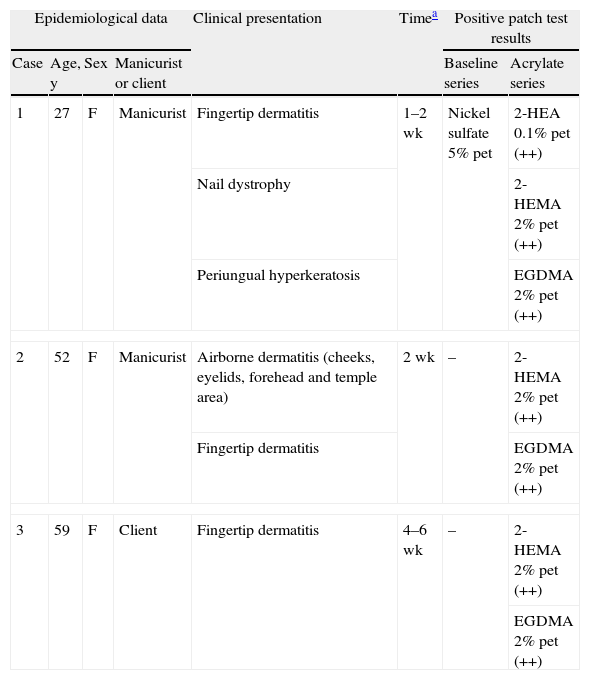Acrylates in artificial nails are a well-known cause of allergic contact dermatitis (ACD).1 The recent emergence of photobonded acrylic gel nails has resulted in a growing number of cases of ACD in both manicurists and clients.2 As the number of beauty salons offering these new type of nails in Spain is increasing, we might soon see an increase in the incidence of ACD due to acrylates. We describe the case of 3 women, 2 manicurists and a client, with ACD induced by acrylic gel nails. The clinical presentation was different for each patient. Interestingly, 1 of the manicurists experienced an airborne reaction to nail sanding dust.
The epidemiological data, clinical manifestations, and patch test results are summarized in Table 1.
Epidemiological data, clinical presentation and patch test results.
| Epidemiological data | Clinical presentation | Timea | Positive patch test results | ||||
| Case | Age, y | Sex | Manicurist or client | Baseline series | Acrylate series | ||
| 1 | 27 | F | Manicurist | Fingertip dermatitis | 1–2 wk | Nickel sulfate 5% pet | 2-HEA 0.1% pet (++) |
| Nail dystrophy | 2-HEMA 2% pet (++) | ||||||
| Periungual hyperkeratosis | EGDMA 2% pet (++) | ||||||
| 2 | 52 | F | Manicurist | Airborne dermatitis (cheeks, eyelids, forehead and temple area) | 2 wk | – | 2-HEMA 2% pet (++) |
| Fingertip dermatitis | EGDMA 2% pet (++) | ||||||
| 3 | 59 | F | Client | Fingertip dermatitis | 4–6 wk | – | 2-HEMA 2% pet (++) |
| EGDMA 2% pet (++) | |||||||
Abbreviations: 2-HEA, 2-hydroxyehtyl acrylate; 2-HEMA, 2-hydroxyethyl methacrylate; EGDMA, ethylene glycol dimethacrylate; F, female; pet, petrolatum.
Patch tests were performed according to the International Contact Dermatitis Research Group criteria using the Spanish baseline series (T.R.U.E. TEST and allergEAZE) and an extended series of acrylates (Chemotechnique Diagnostics AB). Positive reactions were observed for 2-hydroxyethyl methacrylate (2-HEMA) and ethylene glycol dimethacrylate (EGDMA) in all 3 patients and for 2-hydroxyethyl acrylate (2-HEA) and nickel in the client. The manicurists’ symptoms improved in a few weeks after avoiding contact with the nail gel. The dermatitis on the fingertips of the client resolved following removal of the artificial nails, although nail dystrophy persisted for several months.
ACD due to acrylates in artificial nails was first described in 1956 by Canizares,3 who reported a case of eczema due to acrylic materials present in artificial nails on the left hand of a manicurist. Since then, many other cases have been reported. In Spain, Roche et al.,4 in an observational, retrospective study of patients with ACD due to acrylates used in sculptured artificial nails, concluded that acrylate monomers were important sensitizers for contact and occupational dermatitis.
Artificial nails can contain many kinds of acrylic monomers,2 but most cases of ACD are induced by 2-HEMA, 2-hydroxypropyl methacrylate (2-HPMA), and EGDMA.1 Both manicurists and clients can be affected.5,6 Patients present a wide variety of symptoms, such as hand eczema (the most common symptom), nail changes, paraesthesia, and airborne dermatitis.7
Photobonded acrylic gel nails are the latest trend in artificial nails and need weak exposure to UV radiation to polymerize.2 In 1990, Fisher8 presented a case of a woman with paraesthesia and nail dystrophy secondary to sculptured acrylic nails. Acrylic gel nails were recently introduced in Spain, and as they are quite affordable, it is possible that we will see many new cases in the coming years. Most patients usually present with fingertip and/or nailfold dermatitis but other manifestations include facial dermatitis and paraesthesia.2 Acrylic gel nails contain similar acrylic compounds to those found in other artificial nails, with 2-HEMA and EGDMA being the most common.2 Our 3 patients had all been in contact with gel nails before they developed ACD.
Our 3 case reports illustrate that exposure to acrylates in gel nails can induce a wide variety of clinical manifestations in both manicurists and clients. These manifestations include nail dystrophy and airborne dermatitis caused by nail dust. Moreover, acrylates may be present in other common materials such as dental materials or orthopedic prostheses,9 so previously sensitized patients may experience allergic reactions—and even cross-reactions with other acrylic monomers—after re-exposure.1 Individuals with ACD to acrylates in artificial nails can safely use silk wrap nails providing they are not allergic to ethyl cyanoacrylate,1,2 which is present in all nail glues. Furthermore, in cases of occupational ACD, manicurists who decide to continue working with these nails should wear a mask and 4H gloves, which are safer than others as the penetration time for acrylates is over 4h.10
Finally, it is important to alert both manicurists and wearers of artificial nails about the sensitizing potential of acrylates to facilitate the adoption of preventive measures.
Please cite this article: Vázquez-Osorio I, Espasandín-Arias M, García-Gavín J, Fernández-Redondo V. Allergic contact dermatitis due to acrylates in acrylic gel nails: a report of 3 cases. Actas Dermosifiliogr 2014;105:430–432.






